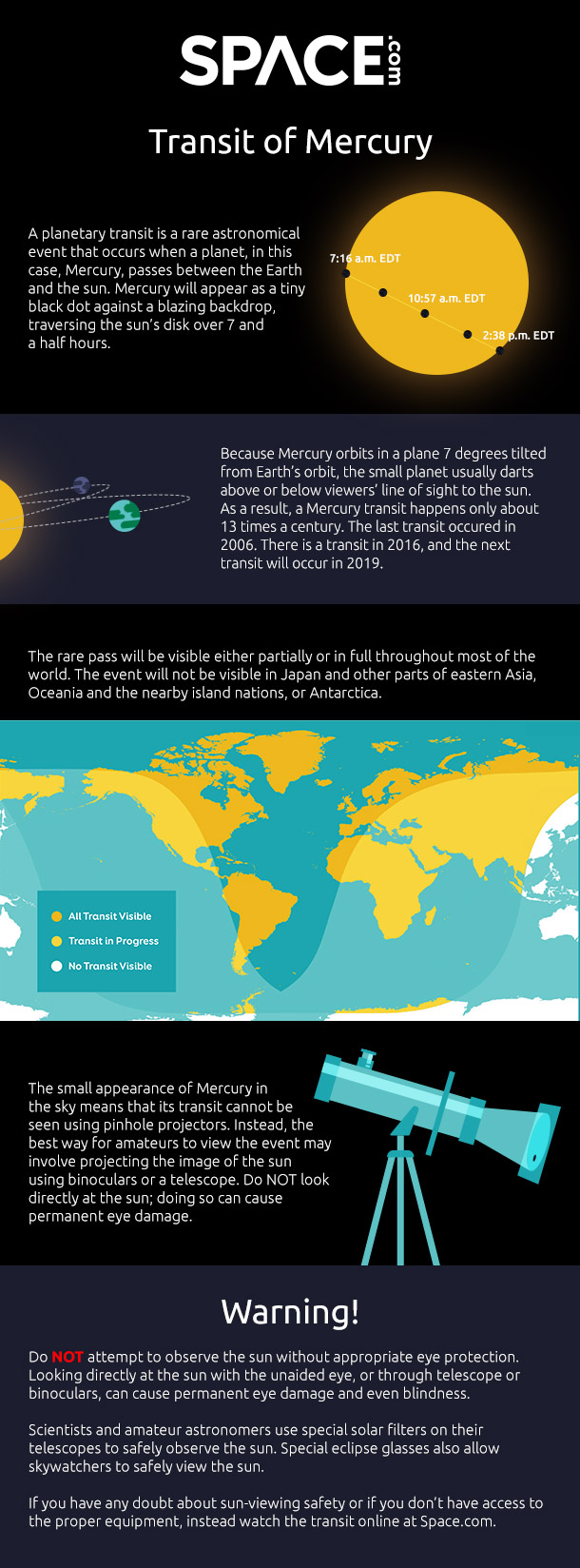The Mercury Transit of the Sun on Monday is a Science Smorgasbord
Mercury's rare passage across the face of the sun on Monday, May 9, should be an exciting event for skywatchers and scientists alike. The planet's pass across Earth's nearest star may provide information about its thin atmosphere, assist in the hunt for worlds around other stars, and help NASA hone some of its instruments.

As seen from Earth, Mercury appears to cross the disk of the sun — an event known as a transit — only about 13 times per century. Currently, transits of Mercury always occur in either May or November (this changes over hundreds of years), with spring transits only occurring about a third of the time.
"During May transits, Mercury's closer to us, so it appears larger than in November," David Rothery, a planetary geoscientist at Open University in the United Kingdom, told Space.com by email. "You can make more precise measurements in May." [The Mercury Transit of 2016: How to See It and What to Expect]
The plane of Mercury's 88-day orbit around the sun doesn't quite line up with the plane of Earth's orbit, so the smaller planet appears to pass above or below the disk of the sun most of the time. The last transit of Mercury took place in 2006, and the next one will occur in 2019. Although the rocky planet appears larger in May, the spring transits are rarer; the next one won't happen until 2049.
Searching for other worlds

During Monday's 7.5-hour transit, scientists will use the giant New Solar Telescope at the Big Bear Solar Observatory in California to try to catch a glimpse of sodium in the planet's thin atmosphere. A planet's atmosphere extends slightly above its surface, so starlight can illuminate the atmosphere when the planet passes in front of a star. On Monday, the scientists hope their observations will help them to better understand how sodium is released from the planet's surface. [The Mercury Transit of 2016: Visibility Maps and Pictures]
Mercury isn't the only planet that transits the sun. Venus makes even less-frequent passages as seen from the Earth — Venus transits the sun in pairs, with the second transit occurring about 8 years after the first. However, the pairs are separated by about a century.
In general, a transit refers to the passage of a object in front of a star (as seen by an observer), and these events are not limited to the bodies in Earth's solar system; NASA's Kepler Space Telescope studied other stars to search for the faint dimming of light that occurs when a planet passes between the disk of the star and the telescope. According to Jay Pasachoff, a professor at Williams College in Massachusetts who will be at Big Bear on May 9, the dimming of light from the 2003 and 2006 transits of Mercury were too faint to be detected, opening a door to understanding the limits of Kepler and the upcoming Transiting Exoplanet Survey Satellite (TESS), which will be launched in 2017.
Get the Space.com Newsletter
Breaking space news, the latest updates on rocket launches, skywatching events and more!
Mercury's transit will be too small to view using homemade pinhole cameras made to study Venus' passage. Telescopes outfitted with special filters will be able to spot the event.
NOTE: Never look directly at the sun without proper protective equipment. Doing so can cause serious eye damage or blindness. Check here to find out how to view the sun safely.
Fixing space cataracts
Specially-outfitted telescopes will also observe the transit from space. The NASA/ESA Solar and Heliospheric Observatory (SOHO) and NASA's Solar Dynamics Observatory (SDO), along with the Japan Aerospace Exploration Agency-led Hinode solar mission, will all study the event.
SOHO launched in 1995 on a mission to study the sun. Two of its instruments will be brought back into full operation during the transit, after spending five years offline, according to a statement from NASA.
The transit will also help calibrate instruments on the various spacecraft. Specifically, it can help scientists determine how to handle stray light in the images collected by the spacecraft. As Mercury crosses the disk, it should look black, but scattered light from the instruments will cause it to appear slightly illuminated, according to the statement.
"It's like getting a cataract — you see stars or halos around bright lights as though you are looking through a misty windshield," Dean Pesnell, SDO project scientist, said in the statement. "We have the same problems on the instruments."
According to Rothery, however, the most valuable thing to come from the transit of Mercury on May 9 may be public education. NASA and other agencies, along with observatories and astronomy clubs around the world and online, will provide the general public with a chance to see the transit for themselves.
"This event is a chance to tell people about Mercury — it's a very perplexing planet for a geologist," Rothery said. "It's important for outreach, to inspire the next generation of scientists."
Editor's note: Visit Space.com on Monday to see live webcast views of the rare Mercury transit from Earth and space, and for complete coverage of the celestial event. If you SAFELY capture a photo of the transit of Mercury and would like to share it with Space.com and our news partners for a story or gallery, you can send images and comments in to managing editor Tariq Malik at spacephotos@space.com.
Follow Nola Taylor Redd on Twitter @NolaTRedd or Google+. Follow us at @Spacedotcom, Facebook or Google+. Originally published on Space.com.
Join our Space Forums to keep talking space on the latest missions, night sky and more! And if you have a news tip, correction or comment, let us know at: community@space.com.

Nola Taylor Tillman is a contributing writer for Space.com. She loves all things space and astronomy-related, and enjoys the opportunity to learn more. She has a Bachelor’s degree in English and Astrophysics from Agnes Scott college and served as an intern at Sky & Telescope magazine. In her free time, she homeschools her four children. Follow her on Twitter at @NolaTRedd









